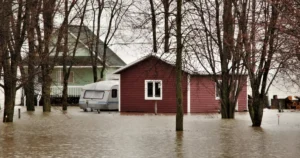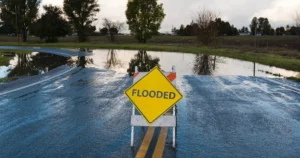Why Every Home Needs Flood Insurance

A flood insurance policy is not just an option—it’s a necessity. Many homeowners assume home insurance policies cover flood damage. Unfortunately, they only realize the gap in coverage after experiencing a flood event. Whether you live in a high-risk flood area or a low-risk area, the risk of flooding is real. Heavy rains can lead to sudden flooding.
Overloaded drainage systems struggle to keep up, causing water to back up into homes. The overflow of inland waters adds to the destruction, leaving property owners vulnerable to severe damage. Even an inch of water can lead to costly repairs. It can damage your home’s structure and ruin essential personal property like water heaters and appliances.
Without flood insurance protection, recovery can be slow and expensive. Federal aid is often limited, and disaster assistance rarely covers total losses. Many homeowners struggle to rebuild, facing financial stress and delays. Plus, most policies have a 30-day waiting period, so you need coverage before disaster strikes.
Now is the time to explore insurance quotes and secure affordable policies. Protect your home, safeguard your finances, and ensure peace of mind. Don’t wait until it’s too late—invest in flood coverage today.
What is Flood Insurance?

A flood insurance policy protects homeowners, renters, and businesses from flood damage. Standard homeowner policies do not cover flooding, leaving many unprotected. Floods can happen due to heavy rains, overflow of inland waters, or overloaded drainage systems. These events cause costly damage to personal property, water heaters, and plumbing systems.
Whether you live in a high-risk flood area or a low-risk area, flooding is always a threat. This policy covers building policies for repairs. It also includes content coverage to replace damaged belongings. This protection reduces financial stress after a flood event.
Most policies have a 30-day waiting period before they take effect. This applies to the National Flood Insurance Program (NFIP) and private insurance policies. Insurance premiums depend on flood maps, risk levels, and floodplain management regulations. Some see insurance costs as an extra expense. However, repairing flood loss without coverage costs much more.
Flood coverage is available for homeowners, renters, and businesses. It can be purchased through private insurers or government-backed programs. This coverage is a smart investment. It ensures financial security when disaster strikes. Check out our blog to learn more about how flood insurance works.
Why Should I Insure My Home from Floods?

Flooding is unpredictable and can cause devastating damage. Many homeowners assume they are covered under homeowners insurance policies, but that’s not the case.
Without flood coverage, repair costs can be overwhelming. Protecting your home with a flood policy ensures financial security and peace of mind.
Protects Against Costly Flood Damage
Flooding can happen anywhere, not just in high-risk flood areas. Even an inch of water can cause extensive flood damage to floors, walls, and electrical systems. Repairing flood loss without coverage can cost thousands of dollars.
Comprehensive flood coverage helps homeowners avoid the financial burden of rebuilding. Without it, many must rely on limited disaster assistance. The best way to prepare for a flood event is to have insurance protection.
Covers Building and Personal Property
A flood protection policy helps pay for repairs to your home and replaces damaged items. It covers things like walls, floors, water heaters, appliances, and furniture. This makes it easier to fix your home after a flood.
Without flood insurance, homeowners may have to pay a lot of money themselves to replace these essentials. Some plans don’t cover expensive items, so you might need extra protection. Families with high-value homes or belongings often look at high net worth life insurance and flood policies to make sure everything is fully covered. Always check policy quotes to find the best coverage for your needs.
Provides Peace of Mind
Flooding can happen with little warning, leaving homeowners stressed and unprepared. A flood policy financial help is available when needed. Relying on federal disaster aid is risky, as it may not cover all damages. Insurance allows homeowners to recover faster without financial hardship.
Having flood protection means less worry during heavy rains and storm surges. Peace of mind comes from knowing your home and belongings are covered.
Ensures Quick Claim Payouts
Filing an insurance claim is often faster than waiting for government aid. Insurance providers offer direct financial relief to policyholders. This allows for quicker home repairs and replacement of personal property.
Without coverage, homeowners may face long delays in receiving disaster assistance. Claims are processed efficiently, helping families return to normal life sooner. Having a flood policy speeds up recovery after a flood event.
Meets Lender Requirements
Many mortgage lenders require flood insurance for homes in areas with high flood risk. Having this policy helps you follow loan rules and avoid extra fees or penalties. If you don’t have coverage, you could face higher costs from your lender.
Both private insurers and the NFIP offer plans that meet these rules. Even if you live in a low-risk area, flood protection is still a smart choice. It helps boost financial security and protects your home’s value for the future.
What are the Different Types of Flood Insurance Coverage?

A flood insurance policy provides essential financial protection for homeowners and renters. It covers the cost of repairs and replacements after a flood event. Understanding the types of coverage helps homeowners choose the right policy.
Building Property Coverage
This coverage protects the structure of the home from flood damage. It includes walls, floors, electrical systems, plumbing systems, and water heaters. The policy also covers built-in appliances, cabinets, and foundation repairs.
Without building coverage, homeowners may struggle to afford major structural repairs. Flood protection policy ensures quick recovery after a natural disaster. Homeowners should check insurance quotes to find the right flood policy for their needs.
Personal Property Coverage
This type of coverage protects personal belongings damaged by flooding. It includes furniture, clothing, electronics, and appliances. Contents coverage also helps replace valuable items lost due to flood loss.
Without it, homeowners must pay for replacements out of pocket. Some high-value items may need excess insurance for full coverage. Reviewing policy costs helps homeowners choose a policy that meets their needs.
Replacement Cost Value Coverage
Replacement Cost Value (RCV) coverage helps pay to replace things with new items at today’s prices. It does not take away money for age or wear and tear. If a flood ruins your kitchen cabinets or couch, this coverage helps you get brand-new ones like the ones you had.
This coverage is great because it saves you money when fixing or replacing damaged things. But it’s usually only for main homes, not vacation homes. It may also be limited to certain parts of the house or items. Always check your policy to see what is covered.
Actual Cash Value Coverage
Actual Cash Value (ACV) coverage pays for items based on what they are worth. It takes away value for age and use. If your 10-year-old TV gets damaged, you’ll get what it’s worth today, not the cost of a new TV.
This type of coverage often costs less but gives you less money after a flood. It’s mostly used for personal items like clothes, furniture, and electronics. Always read the details of your policy. Knowing what you’ll get back if something gets damaged is important.
Frequently Asked Questions
Do I need flood insurance if I live in a low-risk area?
Yes, flooding can happen anywhere, even in low-risk areas. Flood maps show risk levels, but heavy rains and overloaded drainage systems can still cause flooding. Many flood protection claims come from low-risk areas, where homeowners are often unprepared. Affordable policies are available for these locations at lower rates. It’s a smart investment to avoid unexpected flood loss.
How much does flood policy cost?
Insurance costs vary based on flood maps, location, and coverage amount. Homes in high-risk flood zones have higher homeowners insurance premiums. Properties in low-risk areas qualify for lower rates. Costs also depend on whether coverage is through the NFIP or private insurers. Comparing policy quotes helps homeowners find the best option.
How long does it take for coverage to start?
Most flood protection policies have a 30-day waiting period before coverage begins. This prevents last-minute purchases right before a flood event. Some private insurance policies may have shorter waiting times. Exceptions exist for new home purchases if required by a mortgage lender. It’s best to secure flood protection early to avoid coverage gaps.
Can renters get flood protection?
Yes, renters can purchase flood policy protection for their belongings. A renters insurance policy does not cover flood loss, so separate contents coverage is needed. Personal property coverage helps replace furniture, electronics, and clothing.
Affordable flood coverage policies are available for renters through the NFIP and private insurers. It’s a small investment to protect against unexpected disasters.
Does Flood Insurance Cover Personal Vehicles?
No, this policy does not cover personal vehicles. Flood risk protection only applies to building property and personal belongings inside the home. To protect vehicles from flood damage, owners need comprehensive auto insurance. This type of coverage is offered by auto insurance providers and includes protection against flooding. It also covers damage from storm surges and excess water. If you live in a high-risk flood area, check with your insurance company to confirm your policy includes flood-related insurance for your vehicle.
Is flood insurance required by law?
A flood protection policy is required for homes in high-risk flood areas with federally backed mortgages. Mortgage lenders enforce this requirement to protect their investments. Homes outside flood-prone areas are not legally required to have coverage. However, floodplain management regulations encourage property owners to consider this insurance protection. Even when not required, it’s a valuable safeguard against costly flood damage.
Wrapping Up
A flood insurance policy is one of the smartest investments a homeowner can make. Flooding can happen anywhere, and the cost of flood damage can be overwhelming. Without proper protection, homeowners may face significant financial strain. With this insurance coverage, you can safeguard your property. It also helps protect your personal belongings, ensuring financial security after a flood.
Instead of relying on uncertain disaster assistance, a flood policy ensures quick claim payouts. This allows for a faster recovery and reduces out-of-pocket expenses. Whether you live in a high-risk flood area or not, securing flood damage protection gives you peace of mind. You’ll know you’re prepared for the unexpected.
Luxe Insurance Brokers makes finding the right flood insurance policy simple and stress-free. Our team works with top insurance providers to offer affordable policies tailored to your needs. We help homeowners compare insurance quotes and understand their coverage options. Our experts ensure you secure the best protection available.
Don’t wait for the next flood event—contact us today. Protect your home with confidence.
